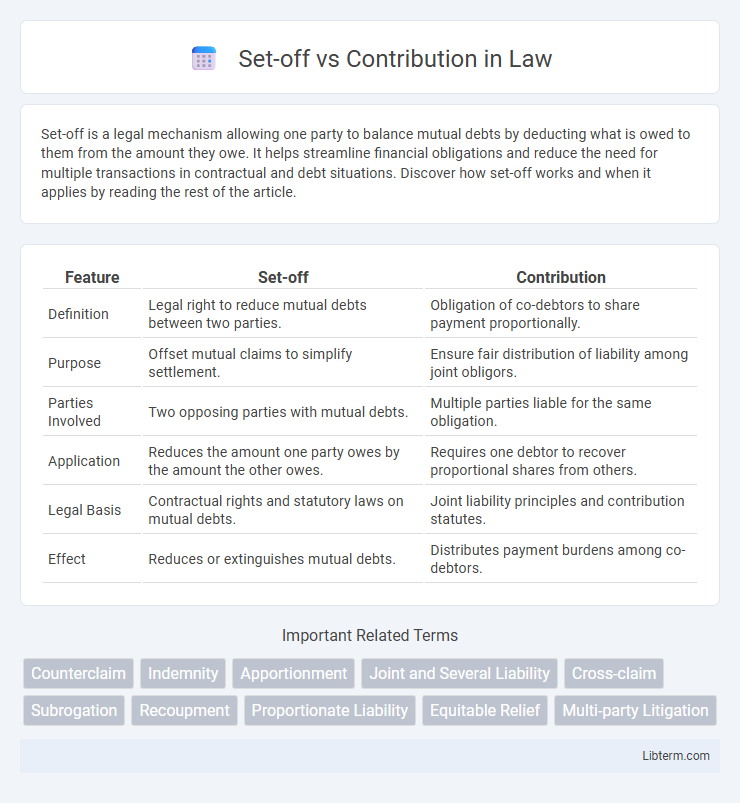Set-off is a legal mechanism allowing one party to balance mutual debts by deducting what is owed to them from the amount they owe. It helps streamline financial obligations and reduce the need for multiple transactions in contractual and debt situations. Discover how set-off works and when it applies by reading the rest of the article.
Table of Comparison
| Feature | Set-off | Contribution |
|---|---|---|
| Definition | Legal right to reduce mutual debts between two parties. | Obligation of co-debtors to share payment proportionally. |
| Purpose | Offset mutual claims to simplify settlement. | Ensure fair distribution of liability among joint obligors. |
| Parties Involved | Two opposing parties with mutual debts. | Multiple parties liable for the same obligation. |
| Application | Reduces the amount one party owes by the amount the other owes. | Requires one debtor to recover proportional shares from others. |
| Legal Basis | Contractual rights and statutory laws on mutual debts. | Joint liability principles and contribution statutes. |
| Effect | Reduces or extinguishes mutual debts. | Distributes payment burdens among co-debtors. |
Introduction to Set-off and Contribution
Set-off is a legal mechanism allowing mutual debts between parties to be netted, reducing the payable amount to a single balance. Contribution involves sharing a common liability or expense among multiple parties in proportion to their respective liabilities or benefits received. Understanding the distinction between set-off and contribution is essential for managing financial obligations and resolving claims efficiently in legal and commercial contexts.
Defining Set-off
Set-off is a legal mechanism allowing a debtor to reduce the amount owed to a creditor by deducting a sum the creditor owes to the debtor, effectively balancing mutual debts. It serves as a defense in financial transactions, ensuring that only the net amount is payable when reciprocal obligations exist. This concept differs from contribution, which involves sharing liability among multiple parties rather than offsetting debts.
Defining Contribution
Contribution refers to the equitable sharing of liability or costs among parties when one party has paid more than their fair share in a joint obligation. It ensures that each party reimburses or compensates others proportionally based on their respective responsibilities or benefits. Unlike set-off, which involves mutual debts extinguishing each other, contribution specifically addresses the distribution of a common burden to achieve fairness.
Legal Basis for Set-off
The legal basis for set-off is primarily rooted in contract law and statutory provisions that allow mutual debts between parties to be extinguished to the extent of the lesser claim. Civil codes and commercial laws often codify the conditions under which set-off can be invoked, including the requirement that the debts be reciprocal, liquidated, and due. Courts typically require clear evidence of mutual obligations and may exclude claims subject to dispute, emphasizing the legal framework that distinguishes set-off from contribution, which arises mainly from equity and restitution principles.
Legal Basis for Contribution
The legal basis for contribution stems from the principle of indemnity, ensuring that each party who has paid more than their fair share in a common liability can recover the excess from other liable parties. Contribution is typically governed by statutes and equitable doctrines requiring proportional sharing of a debt or obligation among cosureties or joint tortfeasors. Unlike set-off, which allows mutual debts to be extinguished against each other, contribution mandates the reimbursement among parties for expenses or payments made on behalf of others under a shared liability.
Key Differences Between Set-off and Contribution
Set-off involves deducting mutual debts between two parties to simplify financial obligations, while contribution requires a party to pay a proportionate share of a liability incurred jointly with others. Set-off typically applies to established debts owed reciprocally, whereas contribution arises when one party has paid more than their fair share of a common liability from which all benefit. The key difference lies in set-off resolving mutual debts directly between parties, while contribution enforces equitable sharing of a collective financial responsibility.
Practical Scenarios: When to Use Set-off
Set-off is commonly used in practical scenarios where two parties owe mutual debts, such as in contractual disputes or creditor-debtor relationships, allowing one party to reduce their liability by the amount owed to them. It is particularly effective in insolvency cases, where a creditor's claim against a debtor can be offset against the debtor's claim on the creditor, streamlining settlements and minimizing payouts. Contribution, by contrast, is typically applied when multiple parties share a common liability, requiring fair distribution of financial responsibility rather than reduction of debts between individuals.
Practical Scenarios: When to Use Contribution
Contribution is used in practical scenarios where multiple parties share liability for a debt or obligation, ensuring that each party pays their fair share. It commonly applies in joint insurance claims, co-guarantor loan defaults, and shared property expenses where one party initially covers more than their portion. This equitable adjustment prevents unjust enrichment by allowing the paying party to recover excess amounts from others responsible.
Advantages and Limitations of Set-off and Contribution
Set-off allows parties to reduce mutual debts, improving cash flow efficiency and minimizing credit risk by offsetting liabilities against receivables, but it is limited to debts between the same parties and may not apply in bankruptcy cases. Contribution involves sharing joint obligations among co-debtors, ensuring equitable distribution of liabilities, yet it can complicate settlements and requires clear identification of each party's share. While set-off streamlines debt settlements through direct offsetting, contribution provides a mechanism for fairness among multiple obligors with shared responsibilities.
Summary: Choosing the Right Approach
Set-off reduces mutual debts between parties, simplifying financial transactions by allowing a debtor to offset their liability with a creditor's claim. Contribution involves sharing a common obligation proportionally among parties, ensuring equitable distribution of payment responsibilities. Selecting between set-off and contribution depends on whether the scenario involves mutual debts or joint obligations requiring fair cost allocation.
Set-off Infographic

 libterm.com
libterm.com